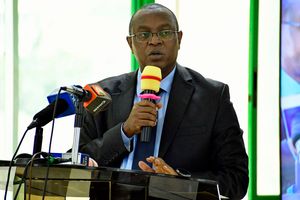Premium
Revolution: How Internet access is changing the face for Lamu

Adam Lali, a resident of Kiwayu Island browses news on his phone.
For decades, residents of the islands that make up the Lamu archipelago were mocked by other Kenyans because they often received news and information later than other parts of the country.
To date, the islands, which include Lamu Old Town, still receive newspapers more than 12 hours after the rest of the country due to transport challenges.
However, technological advancements have brought significant change, with Lamu residents now at par with the rest of the world in terms of access to news and information.
In the remote island of Kiwayu near the Kenya-Somalia border, Mr Bakari Kombo recounts how they used to live in the dark 20 years ago. Kiwayu is among the more than 35 islands making the Lamu Archipelago.
Others include Mkokoni, Kiunga, Ishakani, Pate, Ndau, Faza, Kizingitini, Siyu, Shanga-Ishakani, Rubu, Mwongo Sharif, Mtangawanda, Shella, Ras Kitau, Lamu, Manda, Matondoni, and Kipungani. These islands are accessible mostly by water transport.
“We were unable to get news from other parts of the country and the world. Newspapers didn’t reach us and if you got one, it was stale by a week or a month.

Michael Charo, a resident of Lamu's Mkomani area browses news using his smartphone. He says the internet has greatly helped to simplify news consumption.
“Radio frequencies were unavailable. Today, consuming news is easy and fast. Kiwayu is well networked. We can now access all kinds of news and updates just through browsing the internet on our mobile phones,” he says.
Mr Adam Lali, another resident of Kiwayu, says the internet has significantly transformed how news is consumed here.
Apart from the usual browsing for news and trending issues on the internet, says Mr Lali, people connect on social media platforms, which have also become vital communication and networking tools.
Social media has brought the rest of the world right to their doorsteps, Mr Lali says, and they are now able to keep up with the trending issues of the day.
“We can livestream any of the TV channels we want. Social media is a powerful tool for sharing ideas, amplifying voices and nurturing virtual communities even those living in these remote and forgotten islands of Lamu,” says Mr Lali.
Media organisations across the world are investing heavily in digital infrastructure in a bid to keep up with the changing trends of technological advancement.
Besides this, public and private entities involved in the construction, maintenance and distribution of internet services have also been striving to reach the most remote parts of the country in recent years.
According to a report by the Communications Authority of Kenya (CA), mobile data subscriptions in the country were at 49,355,495 by June 2023.
Mr Ali Aboud, a resident of Ndau, says that, apart from news consumption, the remarkable digital revolution has fuelled social activism and played a crucial role in promoting political inclusivity in the society.
Mr Aboud is, however, concerned about the other villages of Lamu that still lack network infrastructure.

An idyllic street in Lamu Old Town, not much tainted by modern influences. Lamu islanders, often mocked for being “behind the news”, are now taking advantage of internet technology to keep up with the rest of the world.
“We still have islands like Mkokoni, Siyu, Madina, and Mwongo Sharif that still have no mobile phone network, which means that they can’t access news on the internet. We appeal to the government to intervene and introduce strategic initiatives that will enable these islanders to also enjoy network coverage,” says Mr Aboud.





